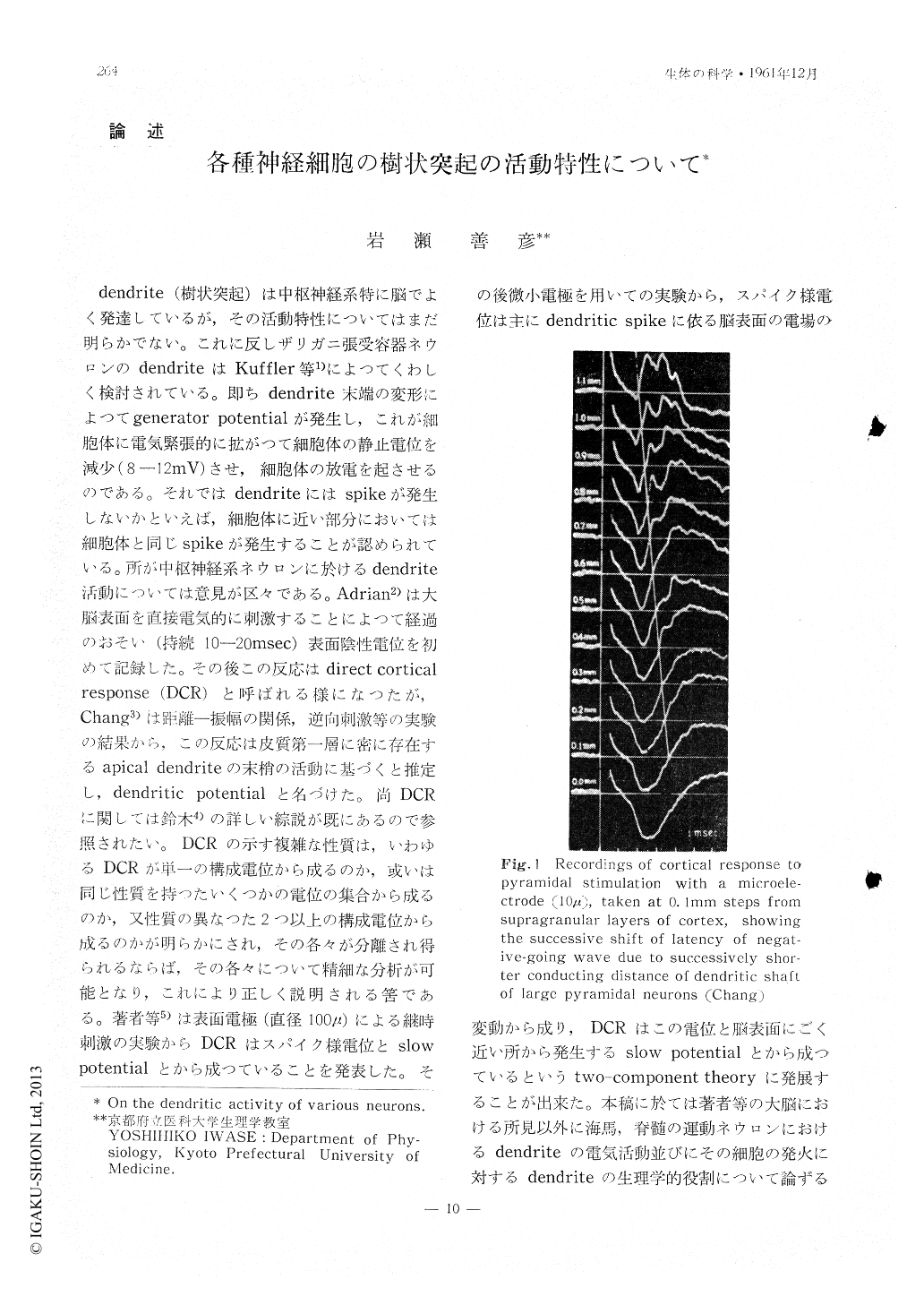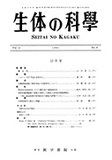Japanese
English
- 有料閲覧
- Abstract 文献概要
- 1ページ目 Look Inside
dendrite(樹状突起)は中枢神経系特に脳でよく発達しているが,その活動特性についてはまだ明らかでない。これに反しザリガニ張受容器ネウロンのdendriteはKuffler等1)によつてくわしく検討されている。即ちdendrite末端の変形によつてgenerator potentialが発生し,これが細胞体に電気緊張的に拡がつて細胞体の静止電位を減少(8-12mV)させ,細胞体の放電を起させるのである。それではdendriteにはspikeが発生しないかといえば,細胞体に近い部分においては細胞体と同じspikeが発生することが認められている。所が中枢神経系ネウロンに於けるdendrite活動については意見が区々である。Adrian2)は大脳表面を直接電気的に刺激することによつて経過のおそい(持続10-20msec)表面陰性電位を初めて記録した。その後この反応はdirect cortical response(DCR)と呼ばれる様になつたが,Chang3)は距離-振幅の関係,逆向刺激等の実験の結果から,この反応は皮質第一層に密に存在するapical dendriteの末梢の活動に基づくと推定し,dendritic potentialと名づけた。尚DCRに関しては鈴木4)の詳しい綜説が既にあるので参照されたい。
Dendritic activity of the neurone has been the subject of considerable study and active debate. There seems still to be a great deal of confusion as to the origin and nature of the direct cortical response called usually dendritic potential. This review will center on the dendritic activity of cerebral cortex, hippocampus and motoneurone and also the impulse initation mechanism of soma.
At first, it is desirable to list, briefly, the general properties of dendritic potential in cerebral cortex. Three hypotheses are proposed as follows:
1. "Electrically excitable" theory; all or none action potential (Chang)
2. "Electrically excitable" theory; graded response conducted upwards only (Bishop and Clare)
3. "Electrically inexcitable" theory: excitatory and inhibitory postsynaptic potentials (Grundfest and Purpura)
The author holds the view of the two-component theory that the dendritic potential is composed of the dendritic spike and slow potential as follows:
(1) The dendritic spike is a spike potential with a refractoriness of 2-3 msec, representing the localized excitation of apical dendritic shaft at a depth of about 0.3mm beneath the surface.
(2) The slow potential showing complete summation is a graded response of the terminal region of apical dendrites in the uppermost layer.
Hence the form and nature of dendritic potential may be dependent upon which part of dendrite is mainly excited. With this interpretation divergent opinions concerning the property of dendritic potential can be explained. The view that the apical dendrites of pyramidal cells are electrically excitable is further supported by the observations that the synaptically evoked spike in hippocampal neurone propagates in the apical dendrite (Andersen), and the afterdischarges by repetitive stimulation are due the excitation of the dendritic shaft (Euler, Green and Ricci). In the Fatt's observation of antidromic response as extracellularly explored in the motoneurone, the second component potential is largely due to the excitation of dendrites, propagating toward dendritic terminals at the rate of 0.7-1.0m/sec. Even with this finding, there remains a question as to the validity of the generally accepted interpretation of notched response, i.e., IS and SD spikes of Eccles. In addition, the observation by Eccles et al. in the chromatolysed motoneurone calls attention to the dendritic activity; the dendrite is excited synaptically to produce a partial spike, and hence to propagate decrementally.
Dendritic activity and its bearing on the impulse initiation mechanism of soma is the greatest problem of the physiology of the nerve cell A possibility to be considered is that in neocortex the dendritic spike spreads electrotonically and excites the somata of pyramidal cells, considering from the latency measurement of soma spikes; usually there is a constant delay of about 2 msec at least. Excitation process of hippocampal neurones was explored intracellularly in detail by Spencer and Kandel who found an intermediate depolarization called a fast prepotential (FPP) preceding the development of the fu11 spike. It is suggested that the FPP results from the dendritic tree of these cells and is essentially identical with the partial spike of Eccles. A possible functional role of the FPP in the impulse initiation of soma has been postulated, i.e., that FPP would trigger the soma and initiate the impulse.
Although further investigation is needed, the conclusion to be drawn from the papers reviewed above is that the dendrite of various neurones may be excited by the direct or indirect stimulation and contribute to the electrogenesis such as graded response or partial spike. Finally, the trigger mechanism of soma is discussed from the point of view of the dendritic activtiy.

Copyright © 1961, THE ICHIRO KANEHARA FOUNDATION. All rights reserved.


